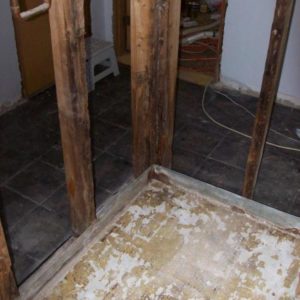I have taken apart my shower and low and behold, there is a lot more damage than I had originally anticipated (isn’t that always the way).
So here is a series of pics showing the shower from the inside and outside.
There is so much I need to ask, but I better start out with the basics.
1) Do I need to remove all of this framing because of the DRY ROT ? (I heard that is spreads)
2) How is the frame pieces on the floor attached ? Are they glued or just sitting on the cement (the ones that run parallel to the floor)
3) Is it adviseable to cut the dry rot out up until the point where it is still good and then put some new 2 X 4 underneath it?
4) Thank you!
























Replies
That doesn't look bad at all. However, I'm anal about rot so I'd be tearing it all out and replacing it with PT, tarpaper and cement board. If the darl wood isn't real soft you could leave it with no real harm since it won't grow without moisture and you're going to do such a good job on the new shower it won't leak. right? The bottom plates are either nailed or screwed down with concrete screws.
Thank you for the response. The wood is solid to a point. I can start to pull pieces off it, but it takes a little doing. There isn't any crumbling into dust for the dry rot. I am also OCD about this stuff and want to do it right, so that is why I thought about taking out the pieces and starting over. The bottom piece, if it is nailed or screwed down is going to give me the biggest amount of grief I would think.
David
I'd start over.
This is your place and why not.
The pcs attached to the concrete are nothing-get a wonder bar and a longer crow bar. Pc. of cake.
Scrape the concrete smooth and fill the old holes-Urethane caulk would be the ticket.
Reframe, make it nice-last forever.
Should I get rid of the metal piece around the cement base? It is rusted in some spots.
Should I get rid of the metal piece around the base? It is rusted in some places.
David
That was the pan.
Start over.
Go to johnbridge.com and read about building a tile shower. Or wait here for somebody not typing on an iPad.
Best of luck
I am starting to dismantle the 2 X 4, and going to start over!
Note that there is no such thing as "dry rot" -- dry wood doesn't rot, it must get wet.
It's hard to tell from the pictures, though, how much is rot and how much is just staining from water leakage and surface mold. Probing with an ice pick or pointed knife blade is the way to tell how rotten the wood may be.
As others have said, you might as well replace the wood (with treated) while everything is exposed, though if you do a good job on the new shower this isn't really necessary -- keep the wood dry and no more rot will occur.
The bottom plate is likely attached with a few nails or ramsets -- a decent sized crowbar will get it up, if you want it up.
I agree with most of the others.... if the wood is soft and punky (poke into it with an awl) then replace it. Trying to scab on after cutting out the bad is false economy. New stock doesn't cost all that much. And forget using pressure treated except for any plates that come in contact with the slab. Why would you want all that chemical soaked lumber in your house? Offgassing is bad! The framing won't rot if the shower is built to not leak.
Treated lumber has bad stability, yet another reason not to use it for studs. I don't think the new stuff is all that dangerous for outgassing, but it corrodes metal. So unless proper fasteners are used, the lumber won't rot, but the whole shebang might fall apart when the screws or nails rust out!
I use PT for almost everything and have no problems with stability at all. Also, the newer PT does not corrode fasteners. Even the stuff that did only did so in wet conditions.